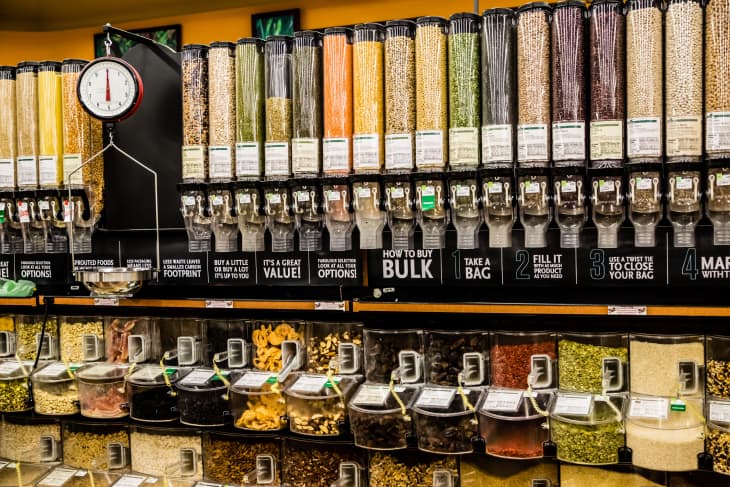The Secrets of Bulk Bin Buyers
The bulk foods section, with its various bins of flours and grains, nuts and seeds, sugars and spices, is the very opposite of the brightly packaged, mass-produced foods of the center aisles. There’s something charmingly retro about the array of tiny textures on display — and it can be sexy, too! When Amelie sticks her hand in a bin of lentils at the corner market, a tingling effect takes over. (Don’t say you don’t want to do the same!)
We went to the bulk professionals to get the inside scoop on just what to scoop when you’re in the bulk section of your grocery.
On a practical level, bulk foods have plenty to offer. They are completely customizable (no one-size-fits-all!), minimize waste in the form of fancy packaging, and they’re often a surprisingly economical choice. Here are a few more insights from the people who actually fill up those seemingly bottomless bins when they empty out.
The Most Popular Bulk Bin Buys
“You can kind of tell what’s going on outside by what people are buying in bulk,” says John Frankenfield, a bulk associate at Lucky’s Market, a natural food store based in Boulder, CO. “When it’s cold, we start going through grains and oats. Bread flours are going, too. People are baking a lot of bread because it’s really cold.”
According to Jace FitzGibben, the former bulk (and now dairy) buyer at a Whole Foods in St. Louis, it’s also fruit and nut season. The walnut, pecan, and cranberry bins get a lot of love during the holidays, although they tend to be popular year-round, and there’s a rush on black-eyed peas to start off the new year.
The Best Buys at the Bulk Bins
At less than a dollar a pound, “Oats are dirt cheap,” says FitzGibben. He also directs consumers to choose bulk cranberries over the more expensive packaged variety, and has a personal affinity for the dried mangoes.
Frankenfield likes the spice section: “It’s massively cheaper than the spices on the grocery shelf,” he explains. “You can literally walk in and get a teaspoon, and that’s $.25 or less.” He adds that spices can lose flavor in less than six months, so his team keeps an eye on the inventory. “Usually,” he says, “the stuff goes pretty fast.” Black peppercorns and turmeric are two of his best sellers.
More on Bulk Bin Spices: Good Reminder: Buy Spices from Bulk Bins
What You Won’t Find in the Bulk Bins
Dried fruit may cause fruit flies, so they keep a close eye on any dried fruit they do carry in bulk (like the aforementioned mangoes).
Both agree that products that spoil aren’t ideal for the bulk bins. Frankenfield cautions that you won’t find pine nuts or macadamia nuts in the bulk section. “They’d go rancid real fast,” he says.
Other Bulk Facts
- In order to keep bestsellers in stock and to provide a wide variety of items, grocery stores get bulk items from multiple distributors.
- Grains come to stores in 25- to 50-pound paper bags, while nuts, granola, and candy come in smaller quantities — usually in boxes with plastic bags on the inside. Herbs and spices come in plastic bags, as well.
- Need more than your bulk bin holds? Your store may offer to sell you the entire bag at a discounted rate. Ask a manager for details.
What are your favorite bulk bin finds?
